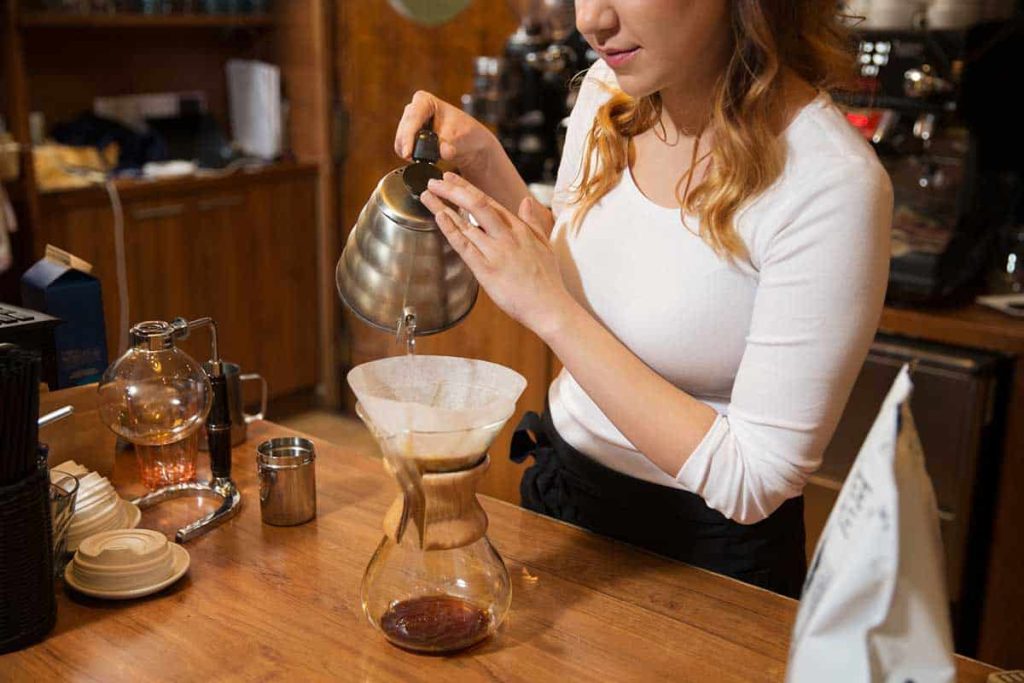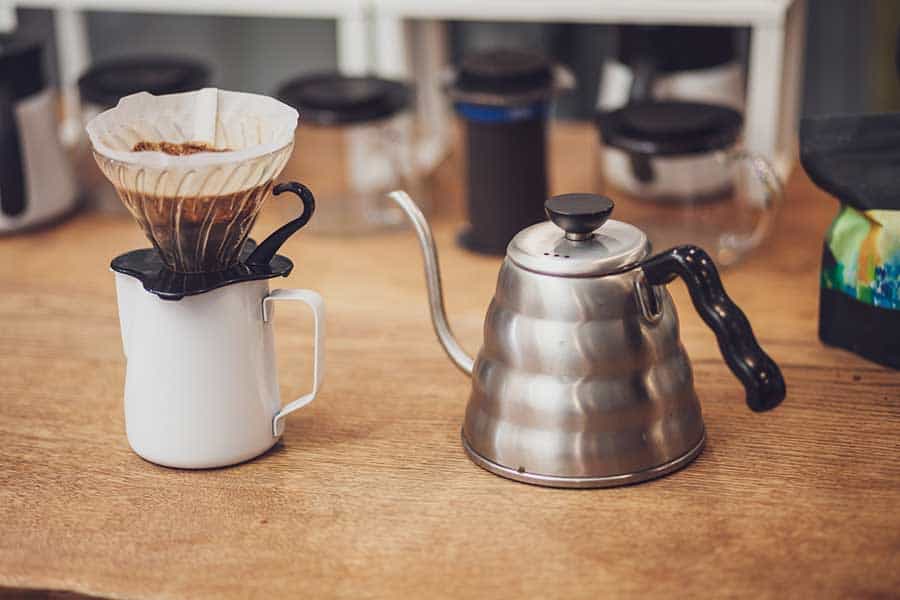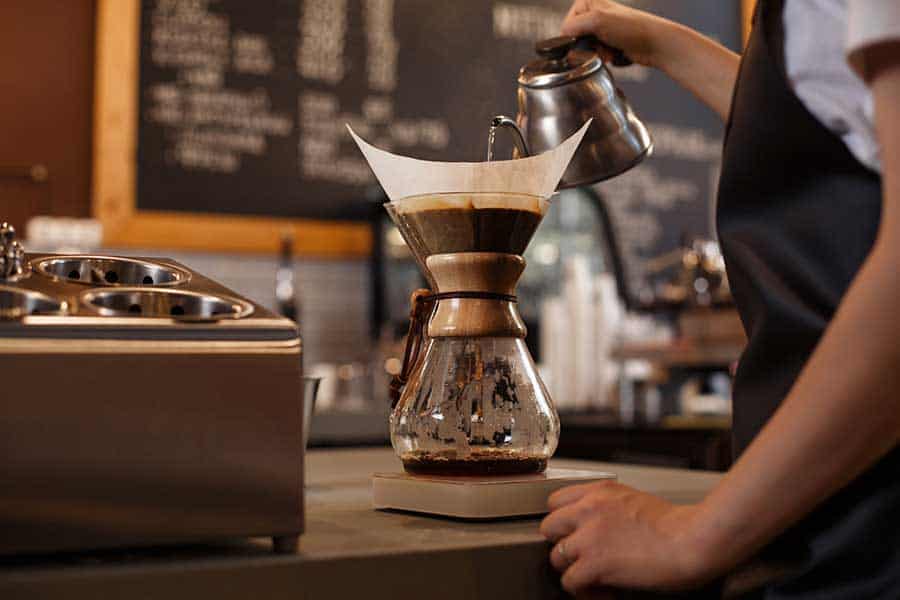The Right Pour Over Coffee Water Temp — Why It Matters

For a great pour over brew, a few crucial elements must come together just right — the beans, the grind, the water quality, the water temperature, the ratio of coffee to water, and the pouring technique.
In this article, we’ll be focusing on you finer details of your pour over coffee water temp. Yep, water temperature is crucial. There can’t be good extraction if your water is not at the right temperature.
So what is the perfect water temperature for pour over coffee? Let’s get into it below.
Pour Over History
Interestingly enough, pour over coffee came into being because of a woman who got tired of subpar coffee that constantly tasted awful.
It was 1908 and Amalie Auguste Melitta Bentz had been using a percolator to make her cup of brew. She was tired of the poor taste and decided to take matters into her own hands. After trying several things, she used blotting paper from her son’s schoolbook and a brass pot that had been punctured by a nail.
With these two items, the pour over was created. It wasn’t until the 1930’s that the Melitta pour overs really gained momentum.
To this day, the Melitta brand is well known for its pour over equipment as well as coffee filters.
How Is Pour Over Coffee Made?
Pour over coffee has certainly made its mark in the coffee world over the last several years. Although it is not particularly complicated to make, a pour over is absolutely considered a specialty brew. It requires a certain level of expertise to create the pour over of your coffee dreams.

One of the biggest draws of pour over coffee is that it really pulls the specific flavors from the coffee beans. You can taste the unique flavors in each type of coffee you create and the taste is always clean and bold.
The process of creating a pour over coffee is very straightforward but does require some expertise. Essentially, pour over coffee is made by pouring water over coffee grounds that are placed in a filter cone. Let’s break down the process a little further:
- Grind the Beans – Before you can even begin to create your cup of java, you must grind the coffee beans. Ideally, a medium coarseness will work best for your pour over and it is a good idea to choose a good quality coffee bean for pour over.
- Rinse the Filter – Filters can give an off-putting taste, so it’s best to rinse the filter before creating your cup of coffee. You can place the filter in your pour over funnel and run water thoroughly over it. Dump the water out of the machine and then place the rinsed filter back inside.
- Place the Grounds – At this point in the process, you will measure the proper amount of grounds and place them into the filter. It is best to put your coffee machine on a small coffee scale so you can have an exact measurement. Typically you want a coffee-to-water ratio of somewhere between 1:15 and 1:18, or 1 gram of coffee to every 15 grams of water. You can use more coffee beans for a stronger coffee or more water for a lighter coffee.
- Pour the Water – Pour water over the grounds. The proper amount of water should be used during this step and you should also use a good pour technique, which we will discuss below.
- Remove the Filter – Once you have finished your pour, the filter can be removed and your incredible cup of coffee can be served.
What Is the Optimal Pour Over Coffee Water Temperature?
It is important to know what temperature water to use for pour over coffee to create a cup of coffee you’ll enjoy. It needs to be just right or you will continue to wish you had spent the extra $5 on coffee every morning. You might be thinking, what temperature does water for pour over coffee need to be?
When you are boiling water to create your pour over, you want the water temperature to be 205 degrees Fahrenheit or about 30 seconds away from the boiling point. To ensure you achieve this temp for pour over coffee, you can use a thermometer. Some people will choose to boil the water first, then check the temperature. If the water has gotten too hot, let the water sit for a minute or two until it has reached the right temperature.
Another great option for heating your water to the right temperature is to use a smart kettle such as this Bonavita kettle. It will allow you to know with absolute certainty that the water temperature is correct.
Why Does Temperature Matter?
The brewing temperature is perhaps one of the most important factors in creating that incredible-tasting cup of pour over coffee. Water is what extracts the flavor from your coffee grounds; if the temperature is not right, the water will not be able to extract the flavors properly. This will lead to major disappointment.
If you boil your water and it is too hot for the coffee grounds, then you run the risk of over-extracting from the coffee grounds.
When you over-extract, your coffee will taste bitter; however, the opposite is true as well. If the water temperature is too low, the water will not be hot enough to extract much flavor from the grounds. This results in under-extraction and coffee that can taste sour or not have enough flavor.
An Important Note on Pour Technique
It is important to not only use the proper temperature of the water, but the right pour technique to ensure that your cup of pour over has the best taste possible.

The pouring portion of the pour over process has two parts. The first part is the bloom portion of the pour. As you pour the initial amount of water (30 grams is a good amount,) you will notice the coffee grounds swell and bubble. During this time, they are releasing CO2. Every coffee bean has some CO2 inside of it as it grows.
When coffee is ground, the surface area increases, and the coffee beans will de-gas much quicker than when they are whole. The reason that the bloom portion of this process is of such high importance is that the CO2 gasses do not allow water to come in contact with the coffee, which will affect your brew. Letting the coffee beans de-gas will allow water to come in contact with the beans to make the best cup of coffee possible.
Approximately 30 seconds after the first pour, you can pour the rest of the water over the coffee grounds. At this point, you will want to thoroughly cover your beans in a pattern of circles to cover all of the grounds. Once this last bit of water has drained through, your brew is complete.
FAQs
Does the quality of water matter?
You don’t want to use water to make your coffee that you wouldn’t drink. It is best to use filtered water for your pour over coffee to ensure the best-tasting coffee possible.
Is the French press the same?
A French press coffee machine is different from a pour over machine. The French press is using pressure to extract flavor, while the pour over is using gravity to push the water through the coffee grounds to extract the flavor.
Pour over coffee is also considered less acidic due to the filter keeping some of the natural oils out of the coffee that you create.
What filter to use for pour over coffee?
It is a good idea to use a filter that is specifically designed for pour over coffee. This will ensure that it is made of the right materials and will allow the water to filter through the grounds correctly, thus creating your insanely good cup of coffee.
What size of coffee grind is ideal for pour over coffee?
The best size of coffee grind for pour over coffee is medium or medium-fine. The size of the grind is important so you do not have over-extraction or under extraction of the coffee beans.
The Final Scoop
Now you know how in-depth creating a cup of pour over coffee truly is. It is important to have all of the right pieces including the proper temperature of the water.
The only way to create the perfect cup of pour over coffee is to use the right temperature for the water, the proper amount of coffee grounds, and good quality coffee beans.
By doing these things you will ensure that you won’t be tempted to stop for a cup of coffee on the way out the door each morning and can enjoy a great cup of coffee right at home.
Owen is a writer and editor at Caffe Streets who considers himself a coffee fanatic. He spends his time researching and testing different coffee beans and brewing methods and sharing what he learns with others.






